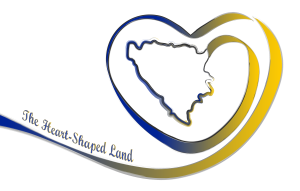
Bosnia and Herzegovina…a long name for geographicly small area but short for an area with such a huge amount of historical, cultural and natural heritage.
Over an area of only 51 209,2 km2 you can witness the living traces of Ottoman and Autro-Hungarian rule, feel the history of different races and religions that have mixed over centuries, and discover what modern Bosnia and Herzegovina means today.
It is believed that the name of the country comes from the eponymous river Bosna. Bosna was first metioned in the mid 10th century by Konstantin Porfirogenet as „HORION BOSONA“.
Since then the name of Bosnia has remained until today, only the geographical area it encompasses has spread. The name Herzegovina comes from the title “Hercog“ which was given to Stjepan Vukčić-Kosača after defeating/victory over King Tomaš in 1448. Since then the area that was ruled by Stjepan Vukčić-Kosača was named as Herzegovina.
Bosnia and Herzegovina is located in Southeastern Europe, on the West Balkan peninsula. Neighbouring countries are Croatia ( N, W, S,) Srbija (SE, E) and Montenegro (JE).
Bosnia and Herzegovina has been an independet, sovereign and territorially integral state throughout the Middle Ages; Under the Ottomans(1463- 1878) and Austro-Hungarian occupation (1878-1918); Part of Yugoslavia and independent again from 1992. As the Republic Bosnia and Herzegovina. After international recognition of the Republic of Bosnia and Herzegovina in the 1992, the war started and lasted untill 1995 until the Dayton Agreement. On the basis of the Dayton Peace Agreement the area of Bosnia and Herzegovina are identifed as two seperate entities; the Federation of Bosnia and Herzegovina, and Republic Srpska and District Brčko.
Bosnia and Herzegovina is one integral country with very complex political regulations, but also with great diversity of natural and cultural herigate. The area of Bosnia and Herzegovina is very specific, interesting and a place which can’t be easily forgotten.
In this small area we call home, you can enjoy abundant natural landscapes like mountains, rivers, canyons and villages. You can visit middle age castles, museums under the sky and much more. To try and understand Bosnia and Herzegovina, it is not enough to read about it, you need to feel it. You need to feel the hospitality of Bosnian muslim, catolic, jewish or ortodox people, feel the fresh air in the mountain villages, feel the coldness of the river water which is warming your soul. This is the real way to undestand what Bosnia and Herzegovina is.
